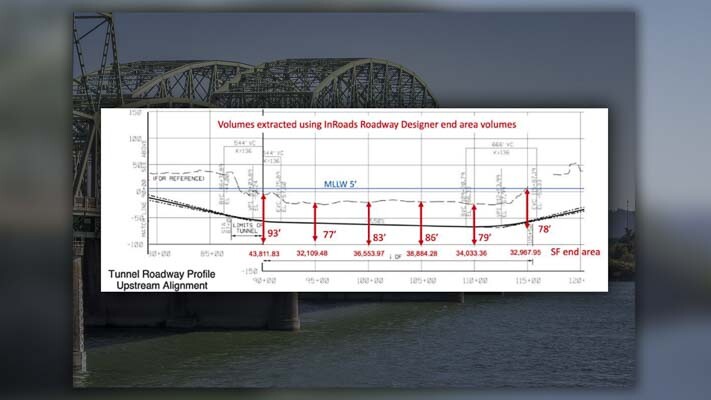
IBR miscalculates amount of excavation needed by a factor of four
John Ley
for Clark County Today
The Interstate Bridge Replacement (IBR) team says quantity errors are not uncommon in the development of conceptual work. That was demonstrated after the price tag for the project jumped from a $3.2-$4.8 billion initial estimate, to $5-$7.5 billion estimate. But two years after discounting an Immersed Tube Tunnel (ITT), new quantity errors appear to have surfaced.
Retired engineer Bob Ortbland has been encouraging the IBR team and politicians to consider an ITT for a crossing of the Columbia River. He knows it would not inhibit marine traffic, like the current 116-foot IBR proposal. An ITT frees up valuable land on the Vancouver waterfront. It also avoids a large footprint on Hayden Island, ground zero for the project.
Two years ago, the IBR team dismissed a tunnel along with other options including a third bridge. They said “cost estimates for a tunnel are estimated to be approximately two times higher than cost estimates for a replacement bridge and approaches.” That was before the cost estimates for the IBR proposal had nearly doubled…
The IRB’s 116-foot bridge proposal remains a stop light for marine traffic on the Columbia River. The US Coast Guard has rejected the proposal, demanding at least 178 feet of clearance. Whereas for the same or likely less cost, an ITT would not hinder any maritime vessels.
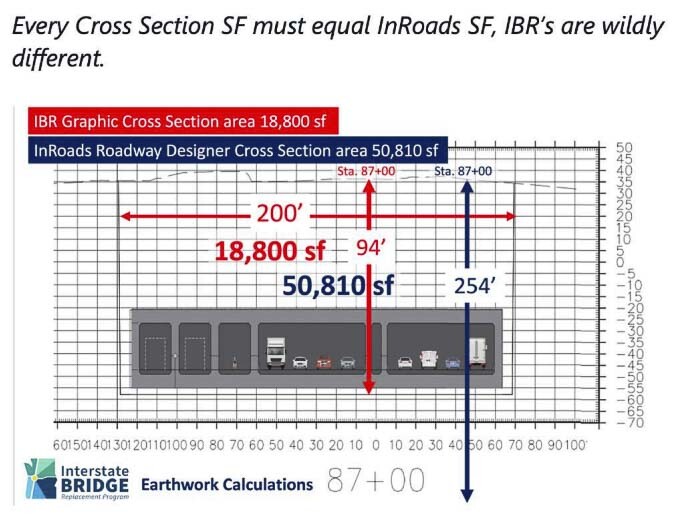
On July 17, 2021, IBR Program Administrator Greg Johnson presented initial findings and their Tunnel Concept Assessment. He praised his staff and their consultants. “We have done our research,” he said. “We brought in experts.”
Johnson said WSP “is one of the most creative international consulting firms in the world.” He told Ortblad: “We have spent hundreds of thousands of dollars to answer your question, we have answered your question” in reference to an ITT option.
In a published memo six weeks later, the IBR said: “Both replacement and supplemental tunnel options were evaluated as part of the alternatives screening process during the Columbia River Crossing (CRC) Environmental Impact Statement (EIS) phase and were ruled out due to their inability to address the six identified transportation problems.”
Two years later, following multiple requests for details, Ortblad received documents regarding the excavation required for an ITT. Those calculations showed 7.9 million cubic yards of material would need to be removed. Ortblad was stunned.
“I questioned the extremely large estimate of excavation and dredging,” he said. “IBR’s estimate of 7.9 million cubic yards is four times a realistic estimate of 2.1 million cubic yards. I asked for supporting calculations but was denied.” But, Ortblad persisted.
When that documentation was eventually provided, the retired engineer did his own calculations. He revealed multiple flaws in what the consultants had provided. Initially, the documents weren’t even stamped, failing to show the official certification of the engineering calculations. That added to Ortblad’s concerns.
According to Ortblad, the IBR/WSP calculations required the depth of the ITT to be much deeper than actually required. The only way to get 7.9 million cubic yards of materials from the river was digging deeper. Cross sections showed that the IBR tunnel would be at an average depth of 82 feet. Ortblad’s calculations indicated the tunnel could safely be built with an average depth of just 45 feet, which he shared with the IBR team.
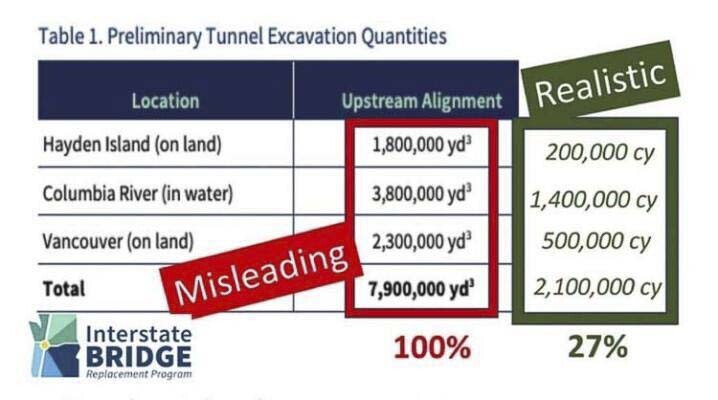
The IBR team responded in a Sept 8, 2023 email, admitting their calculations were wrong. “We have investigated your inquiry and were able to confirm an issue with the model. Duplication occurred in the model where some excavation quantities were counted more than once.” They blamed “third party software”.
“Quantity errors like this are not uncommon during the development of conceptual work,” the IBR team added. This is reminiscent of the original Columbia River Crossing where a bridge was proposed with 95 feet of clearance for marine traffic. It was later revealed the structure could not have been built and a different design was chosen.. Are the same mistakes being repeated?
“While this error does result in a change in the quantity of excavation material, it does not change the decision,” they told Ortblad.
On the Vancouver side, Ortblad calculated an ITT excavation would be just 70 feet in depth. The IBR/WSP calculation required 214 feet. Additionally on Hayden Island, the program showed 232 feet of depth, whereas Orblad showed only 50 feet of depth being needed.
During a meeting with the Hayden Island community late last year, Johnson had berated Ortblad and questioned his credentials during a heated discussion. “Bob has accused folks, who are licensed engineers, of malpractice,” Johnson said. “Bob, where’s your license? Or are you just a citizen who is interested? You are talking about folks who are licensed.”
Johnson told the Hayden Island crowd to “bring the heat” but defended his organization. “We’re not afraid to be challenged, but I will not stand for folks’ reputation being besmirched to say we are putting out inaccurate information.”
Nearly a year later, Ortblad has gotten Johnson’s team to admit their licensed engineers were wrong. They had even added their official stamp, theoretically putting their license at risk.
The IBR analysis showed the tunnel being 190-feet wide. It contained essentially three major tunnel chambers. One for southbound traffic and one for northbound traffic. The third chamber contains the “active transportation” path for pedestrians and bicyclists, plus two chambers for MAX light rail.
Ortblad felt the 190-feet width was unnecessary. He would prefer to repurpose the current Interstate Bridge structures, saving roughly $300 million in bridge demolition costs. He would put active transportation on the older 1917 bridge and the light rail on the newer 1958 bridge.. It would also save hundreds of millions in tunnel costs, eliminating perhaps 50 feet in tunnel width.
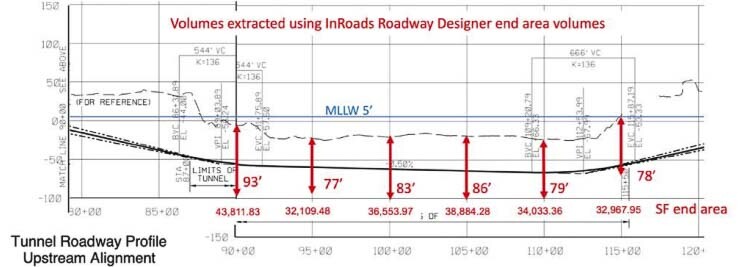
One IBR/WSP graphic showed “volumes extracted using InRoads Roadway Designer end area volumes.” It had a line indicating the bottom depth of the tunnel. But when Ortblad used other calculations they had provided, it showed the required depth being even deeper – 30 to 40 feet deeper than the IBRs tunnel profile.
Another cross section calculation was off by a factor of two and a half times the square footage. The total volumes of materials needing to be removed were one quarter of the IBR/WSP projections, and therefore the ITT would be significantly cheaper than what the IBR told the public and legislators two years ago.
Supplement the bridge
A 2002 Transportation Trades Partnership Task Force suggested either replacing or supplementing the Interstate Bridge. It supposedly was part of the IBR review of past works. In a 2006 CRC evaluation, a supplemental tunnel was considered. It would add vehicle capacity, carrying 45 percent of future vehicular traffic. The existing two bridges would carry 55 percent of traffic
The study evaluated two tunnel options based on the following six criteria. They received grades of “P” for pass, “F” for fail, or “U” for unknown.
Does the component…”
1. Increase vehicular capacity or decrease vehicular demand?
2. Improve transit performance?
3. Improve freight mobility?
4. Improve safety and decrease vulnerability to incidents?
5. Improve bicycle and pedestrian mobility?
6. Reduce seismic risk of the I-5 Columbia River Crossing?
The supplemental tunnel passed five of the six criteria. For component six, “reducing seismic risk” it received an “unknown” evaluation. It did not fail any criteria.
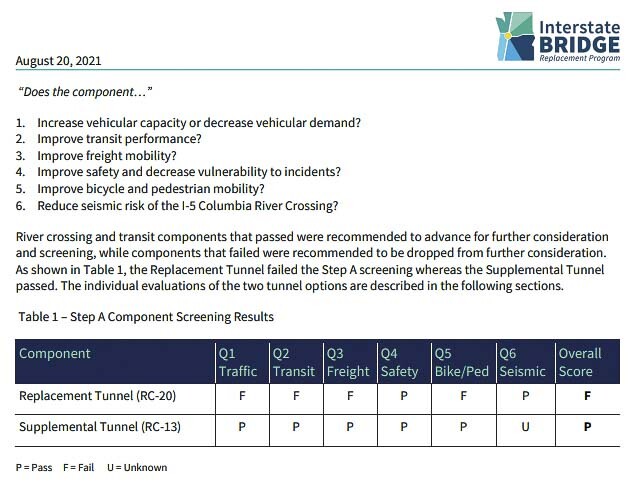
A supplemental tunnel could increase vehicle capacity. It could increase bus transit performance and freight mobility. It is believed that it would improve safety while meeting bicycle and pedestrian mobility needs, especially if the current Interstate Bridges were repurposed. Yet the IBR team in reviewing this data created bad calculations to dismiss an ITT option.
In 2005, David Evans and Associates evaluated two tunnel options for the CRC. The “short” option was a 9,100-foot long ITT that ran from Mill Plain in Vancouver to Marine Drive in Portland. The “long” version was a traditional bored 18,500-foot tunnel. It ran from 20th Street in Vancouver to Victory Blvd. in Portland. Both options retained the current bridges for use by local traffic.
At the time the cost of the ITT was estimated to be $750 million. This is about 5 percent less than the CRC’s projected $792 million price tag for the bridge, according to forensic accountant Tiffany Couch. The long tunnel was estimated to cost $2 billion. Both would have been far cheaper than the final $3.5 billion failed CRC proposal.
The 2005 evaluation by David Evans and Associates stated:
“Both the short and long tunnel options require a massive amount of surplus excavation, both for the cut-and-cover sections for the approaches and for the bored or sunken-tube sections. For the short tunnels, the surplus excavation is estimated between 1-1.5 million cubic yards of material using the minimal sections. The long tunnel is estimated to create between two and 3.5 million cubic yards of material for disposal.”
The experts at WSP and the IBR appear to have failed to compare their 7.9 million cubic yard excavated material estimate with previous studies. If they had, they would have realized there was an error. But it took retired engineer Ortblad to reveal the problem, which taxpayers have now spent six figures of their money on.
The failed CRC was labeled “a light rail project in search of a bridge” by an Oregon Supreme Court Justice. The Federal Highway Administrator from Oregon told people they were basically building a platform for light rail to cross the river into Vancouver.
The current $7.5 billion project includes $2 billion for light rail. As Ortblad noted, light rail could be added later and placed on one of the two current Interstate Bridge structures. His faith in the value of an ITT has only increased in light of recent disclosures.
Also read:
- Plan ahead for ramp closures on I-5 near Ridgefield, July 9-10WSDOT will close three I-5 off-ramps near Ridgefield July 9–10 to test wrong-way detection systems and improve safety.
- Delays expected on Northwest 99th Street during water quality project constructionClark County will begin construction in July to install a stormwater filter vault on NW 99th Street. Drivers can expect delays, but lanes will remain open during the work.
- POLL: What’s the biggest concern you have with the current I-5 Bridge replacement plan?As costs rise and Oregon’s funding fails, concerns mount over the current I-5 Bridge replacement plan. Clark County Today asks readers: what’s your biggest concern?
- Plan ahead for ramp closures on I-5 near Ridgefield, July 8-9Travelers on northbound I-5 near Ridgefield should prepare for ramp closures July 8–9 as WSDOT crews conduct final testing of new wrong-way driving detection systems. The closures affect exits 9 and 11, including the Gee Creek Rest Area.
- Oregon DOT director calls transportation funding bill failure ‘shocking,’ warns of layoffsODOT Director Kris Strickler warned staff that up to 700 layoffs are imminent after lawmakers failed to pass a transportation funding bill, deepening the agency’s $300 million shortfall.









